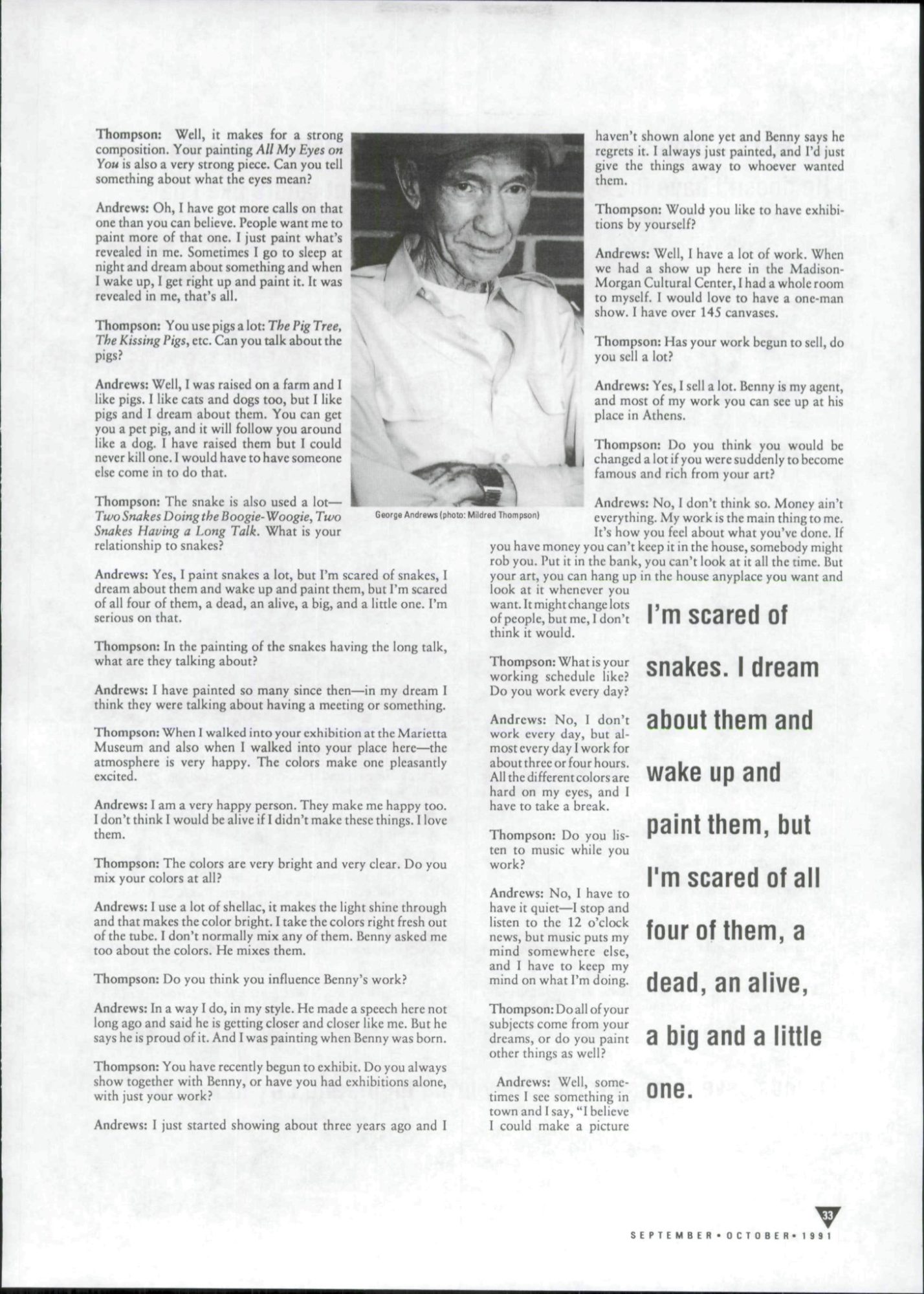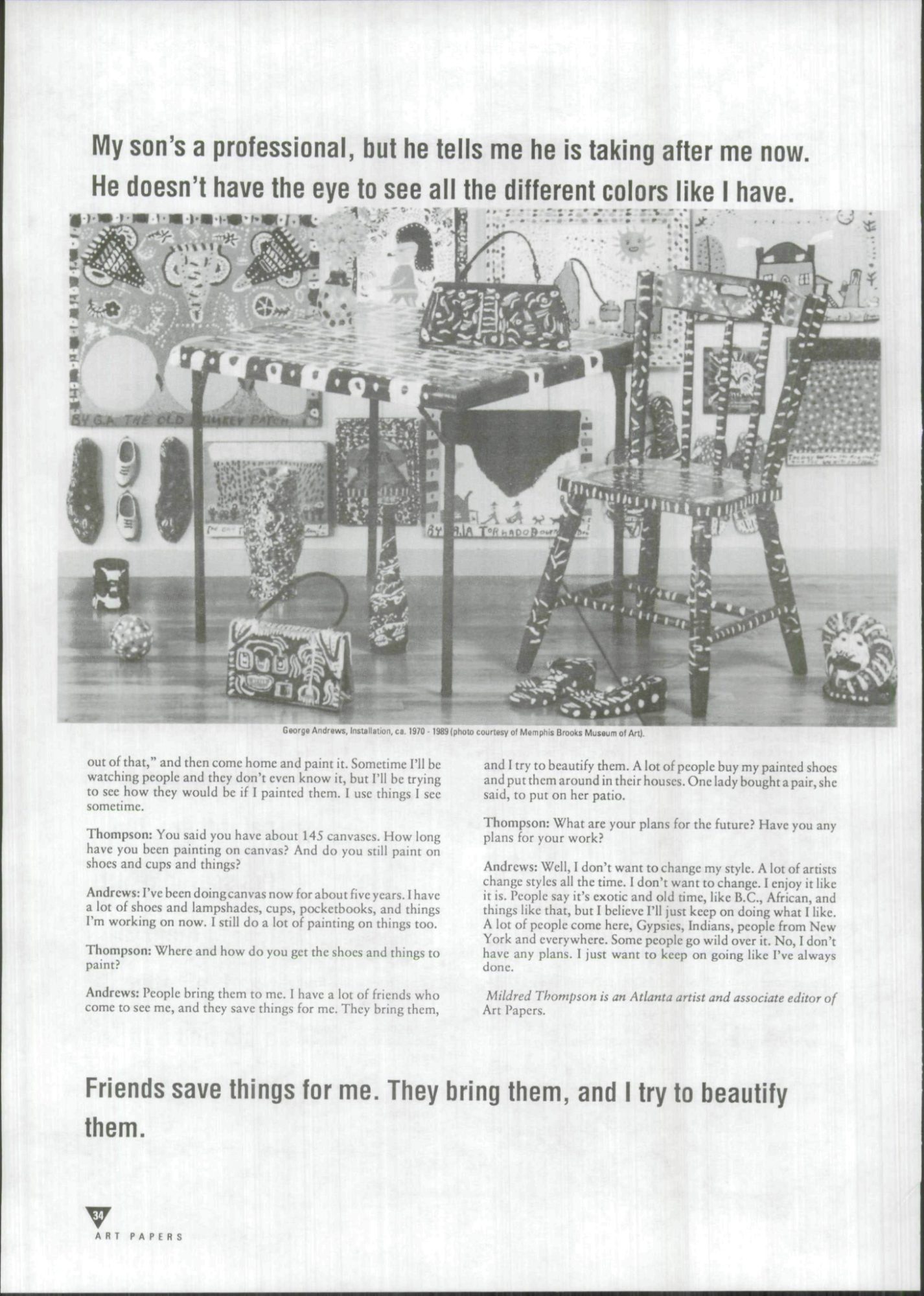George Andrews
Share:
This interview was originally published in ART PAPERS September/October 1991, Vol. 15, issue 5.
George Andrews, the father of the well-known artist Benny Andrews, is a self-taught artist and former sharecropper whose artwork has only recently begun to be exhibited. The following interview with George Andrews was conducted in Madison, Georgia shortly after the opening of the Memphis Brooks Museum’s traveling exhibition “FOLK: The Art of Benny and George Andrews” at the Marietta-Cobb Museum of Art June 21 – August 18.
Mildred Thompson: You once described yourself as a “born painter.” Can you tell us more about that?
George Andrews: Well, I have always painted. I started out using my mother’s bluing that she used for washing. I would mix it with a little flour and water and paint with it when my mama wasn’t at home. I was about five or six years old then. It was just revealed in me, I wanted to be an artist. I wanted to paint pictures. My mama wanted me to be a farmer and didn’t pay attention to art. She has been dead now for about 20 or 25 years and she never did see any of my paintings, because she never was interested in them.
Thompson: Do you see any difference between a “born artist” and an artist who studies?
Andrews: No, well, you see I think I’d rather be what God wanted me to be. See, He revealed all of this into me without education, as high as I got was the third grade.
Thompson: But do you think you or your work would have been any different if you had had the opportunity to study? How do you think being educated would have affected you and your work?
Andrews: Well, I might have been like my son. He’s a professional, but he tells me he is taking after me now. He doesn’t have the eye to see all the different colors like I have. I don’t believe I would have been any different if I had had education, because that’s in me to do what I want to do. Couldn’t nobody teach me to do what God wants me to do. That’s how I feel.
Thompson: We always hear distinctions about artists—the so-called primitive, the folk artist, the untrained, etc. Do you see or feel any differences in the artist?
Andrews: No, I sure don’t. I don’t pay them any attention. They paint what they like, what I paint is what I like and it’s mine. Some of them say they are professionals.
Thompson: What do you think makes one a professional artist?
Andrews: Education, I believe, going to all these art schools and all that. All I know is mine was revealed in me.
Thompson: You speak of things being revealed in you. In some or many of the so-called primitive cultures, in places like parts of Africa, South America, Australia, the artist is determined at birth. If a baby is born with a veil over its face, it is believed that this child will be a so-called witch doctor, shaman, or an artist. And although children may sometimes grow up under the guidance of the village artist or doctor, they learn to understand and practice these revelations. And all of these artists, in their societies, are considered professional. Do you feel that you are professional, in spite of how other people describe you?
Andrews: Yes, in my own way. Yes. My mother was a midwife and she told me that I had been born like that—with a veil over my head. I asked if my brother and sister were born like that, and she said no, I was the only one. I never knew nothing about that until I got much older, but she did tell me that I was born with a veil over my face.
Thompson: In many of your paintings you use two elements very often. Two snakes occur often, two pigs, two trees. Is there some special reason for that?
Andrews: I do that because it fits better that way. Sometimes I use three things but the third will be down at the bottom somewhere. I almost always use two.
Thompson: Well, it makes for a strong composition. Your painting All My Eyes on You is also a very strong piece. Can you tell something about what the eyes mean?
Andrews: Oh, I have got more calls on that one than you can believe. People want me to paint more of that one. I just paint what’s revealed in me. Sometimes I go to sleep at night and dream about something and when I wake up, I get right up and paint it. It was revealed in me, that’s all.
Thompson: You use pigs a lot: The Pig Tree, The Kissing Pigs, etc. Can you talk about the pigs?
Andrews: Well, I was raised on a farm and I like pigs. I like cats and dogs too, but I like pigs and I dream about them. You can get you a pet pig, and it will follow you around like a dog. I have raised them but I could never kill one. I would have to have someone else come in to do that.
Thompson: The snake is also used a lot—Two Snakes Doing the Boogie-Woogie, Two Snakes Having a Long Talk. What is your relationship to snakes?
Andrews: Yes, I paint snakes a lot, but I’m scared of snakes, I dream about them and wake up and paint them, but I’m scared of all four of them, a dead, an alive, a big, and a little one. I’m serious on that.
Thompson: In the painting of the snakes having the long talk, what are they talking about?
Andrews: I have painted so many since then—in my dream I think they were talking about having a meeting or something.
Thompson: When I walked into your exhibition at the Marietta Museum and also when I walked into your place here—the atmosphere is very happy. The colors make one pleasantly excited.
Andrews: I am a very happy person. They make me happy too. I don’t think I would be alive if I didn’t make these things. I love them.
Thompson: The colors are very bright and very clear. Do you mix your colors at all?
Andrews: I use a lot of shellac, it makes the light shine through and that makes the color bright. I take the colors right fresh out of the tube. I don’t normally mix any of them. Benny asked me too about the colors. He mixes them.
Thompson: Do you think you influence Benny’s work?
Andrews: In a way I do, in my style. He made a speech here not long ago and said he is getting closer and closer like me. But he says he is proud of it. And I was painting when Benny was born.
Thompson: You have recently begun to exhibit. Do you always show together with Benny, or have you had exhibitions alone, with just your work?
Andrews: I just started showing about three years ago and I haven’t shown alone yet and Benny says he regrets it. I always just painted, and I’d just give the things away to whoever wanted them.
Thompson: Would you like to have exhibitions by yourself?
Andrews: Well, I have a lot of work. When we had a show up here in the Madison-Morgan Cultural Center, I had a whole room to myself. I would love to have a one-man show. I have over 145 canvases.
Thompson: Has your work begun to sell, do you sell a lot?
Andrews: Yes, I sell a lot. Benny is my agent, and most of my work you can see up at his place in Athens.
Thompson: Do you think you would be changed a lot if you were suddenly to become famous and rich from your art?
Andrews: No, I don’t think so. Money ain’t everything. My work is the main thing to me. It’s how you feel about what you’ve done. If you have money you can’t keep it in the house, somebody might rob you. Put it in the bank, you can’t look at it all the time. But your art, you can hang up in the house anyplace you want and look at it whenever you want. It might change lots of people, but me, I don’t think it would.
Thompson: What is your working schedule like? Do you work every day?
Andrews: No, I don’t work every day, but almost every day I work for about three or four hours. All the different colors are hard on my eyes, and I have to take a break.
Thompson: Do you listen to music while you work?
Andrews: No, I have to have it quiet—I stop and listen to the 12 o’clock news, but music puts my mind somewhere else, and I have to keep my mind on what I’m doing.
Thompson: Do all of your subjects come from your dreams, or do you paint other things as well?
Andrews: Well, sometimes I see something in town and I say, “I believe I could make a picture out of that,” and then come home and paint it. Sometime I’ll be watching people and they don’t even know it, but I’ll be trying to see how they would be if I painted them. I use things I see sometime.
Thompson: You said you have about 145 canvases. How long have you been painting on canvas? And do you still paint on shoes and cups and things?
Andrews: I’ve been doing canvas now for about five years. I have a lot of shoes and lampshades, cups, pocketbooks, and things I’m working on now. I still do a lot of painting on things too.
Thompson: Where and how do you get the shoes and things to paint?
Andrews: People bring them to me. I have a lot of friends who come to see me, and they save things for me. They bring them, and I try to beautify them. A lot of people buy my painted shoes and put them around in their houses. One lady bought a pair, she said, to put on her patio.
Thompson: What are your plans for the future? Have you any plans for your work?
Andrews: Well, I don’t want to change my style. A lot of artists change styles all the time. I don’t want to change. I enjoy it like it is. People say it’s exotic and old time, like B.C., African, and things like that, but I believe I’ll just keep on doing what I like. A lot of people come here, Gypsies, Indians, people from New York and everywhere. Some people go wild over it. No, I don’t have any plans. I just want to keep on going like I’ve always done.

